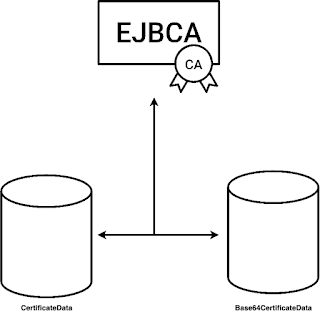Introduction
chromeOS is an operating system based on Chromium (with Google Chrome as its primary UI) which is the default operating system on devices such as ChromeBooks, ChromeBoxes, ChromeBases and similar devices. In order to allow these devices to access the network, ensure internal network security and other PKI use cases, chromeOS can be easily set up to automatically enroll for certificates from EJBCA over the SCEP protocol.
This scenario requires three parties:
The Google Cloud Certificate Connector is a service installed on a third device which acts as an enrollment and administration portal for the enrolling chromeOS devices.
EJBCA Configuration
As a part of this tutorial, it's assumed that you've already installed EJBCA and configured a CA you would like to enroll against.
Certificate Profile
The pertinent fields in the Certificate Profile to set are as follows:
The following values are expected to be available in the end entity profile:
Subject DN Fields
Subject Alt Names
SCEP Alias
Lastly, the SCEP alias has been set up as follows:
Google Cloud Certificate Connector
Installation
The Google Cloud Certificate Connector is downloaded when first setting up your Google Cloud account, as documented here. The Connector needs to be installed on a Microsoft Windows Server.
To do so, perform the following steps:
- Create an Active Directory service account user which will run the Google Cloud certificate connector. This account must have a static password.
- Connect to the Google Admin Console with an administrator account
- Under Devices → Networks, select Secure SCEP connector
- The download connector page will give you access to:
- The Connector Executable
- The connector configuration JSON file (config.json)
- The service account credentials JSON file (key.json)
- Copy all the files downloaded to the server hosting the Google Cloud certificate connector
- Run the installer as an Administrator
- Provide the AD service account user
Note: The connector cannot be installed with a non domain account - Install the connector
Configuration
- Put the connector configuration JSON file (config.json) and the service account credentials JSON file (key.json) in the Google Cloud certificate connector folder (Default location is: C:\Program Files\Google Cloud Certificate Connector).
- For the SSL handshake between the Google Cloud Certificate Connector and EJBCA to properly work, EJBCA's Management CA certificate needs to be added to the CA store of the Google Cloud certificate connector:
- Locate the CA store of the Google Cloud certificate connector (default location is: C:\Program Files\Google Cloud Certificate Connector\rt\lib\security\cacerts)
- Either install a Java SDK on the Google Cloud certificate connector server or copy the cacerts file to a computer where a Java SDK is installed
- Add the Management CA certificate using keytool:
keytool.exe -import -keystore ./cacerts -trustcacerts -file <ManagementCA.pem> -storepass changeit
- Copy the cacerts file back to the Google Cloud certificate connector server (default location: C:\Program Files\Google Cloud Certificate Connector\rt\lib\security) if keytool wasn’t run on the server itself.
- Start the Google Cloud Certificate Connector service.
- Check that everything is properly started in the event viewer:
- The Google Cloud Certificate Connector should be able to parse its configuration:
- Initialize the service
- Every 30 second the service will check against the Google backend if there are any requests to process
Adding your own CA to Google Cloud
- Connect to the Google admin console with an administrator account
- Under Devices → Networks → Certificates, select Add certificate. This should be done the root of the Google domain or for Chromebooks root OU
- Provide a name for the CA, or otherwise the common name of the issuer will be used), then upload the CA certificate in PEM format and choose to deploy on Chromebooks
SCEP Profile Configuration
- Connect to the Google admin console with an administrator account.
- Under Devices → Networks → Secure SCEP connector, select Add secure SCEP profile. This can be done at the root domain level, at Chromebooks root OU in case of device certificates or Users root OU in case of user certificates.
- Set a profile name, subject and the key size. The following example is focused on issuing device certificates, but can easily be adapted for user certificates:
CSR subject fields are defined in the SCEP profile. Placeholder variables can be used in order to customize the CSR to the need. Available placeholder variables are defined in this article. - If needed, Subject Alternative Names (SANs) can also be added:
- Configure:
- The SCEP server URL, which should look something like https://<hostname>:<port>/ejbca/publicweb/apply/scep/<alias>/pkiclient.exe
- the certificate characteristics
- the static challenge (pass-phrase) used to authenticate the request coming from the Google Cloud certificate connector on the SCEP server and the corresponding certificate authority.
- Configure how this template should be applied on ChromeBooks, per user or per device:
Testing
- Connect to a user session on the ChromeBook.
- Ensure that the device/user gets the policies to create the certificate request in chrome://policy (RequiredClientCertificateForDevice for a device certificate and RequiredClientCertificateForUser for a user certificate)
- Under chrome://certificate-manager, follow the certificate creation process.
- On the Google Cloud certificate connector event viewer, look for the following events:
- Processed Requests
- Google Cloud Certificate Connector submitting the SCEP request to EJBCA and receiving a certificate
- ACK message between the Connector and the Google backend, pushing certificate to the Chromebook
- Check that the certificate has been properly added to the Chromebook under chrome://certificate-manager
- In the case of a device certificate, this process is also triggered just after a device enrollment




































